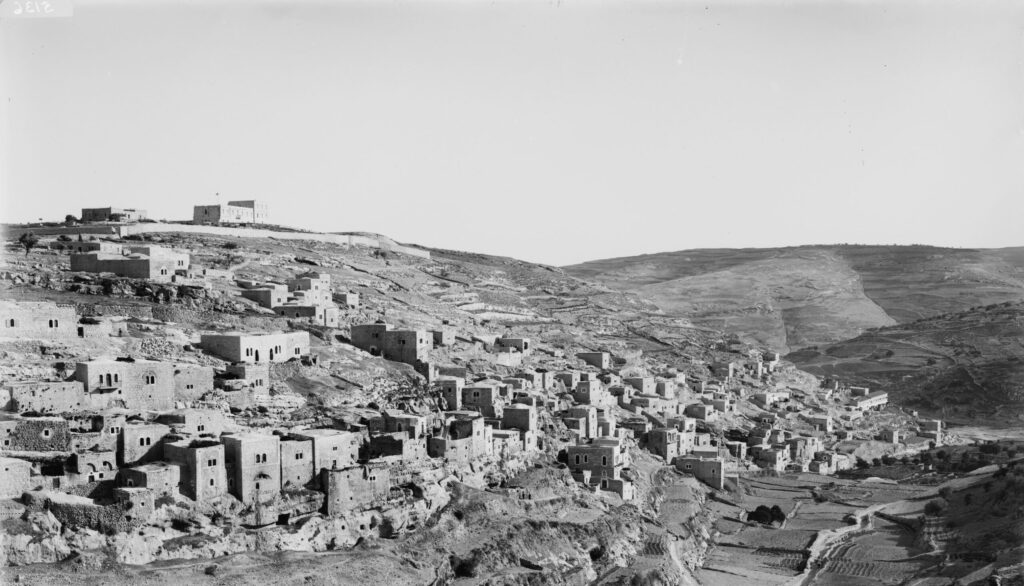Our History
South of the Mount of Olives, the Mount of Scandal (or the Mount of Perdition) appears in the second Book of Kings (2 Kings 23, 13) reasons less honorable than that of housing the House of Abraham on its summit: King Solomon had built altars there to the pagan gods Kemos and Moloch, worshipped by his many mistresses.
Already at the time of Herod, the Mount of Olives would have been used as a place of camp for many pilgrims, in view of the debris of pots and pans abandoned by the pilgrims found on the spot (according to Vincent Lemire, in L'Histoire de Jérusalem)
It was also on the Mount of Olives that Jesus came to pray and weep and was handed over to the Romans.
Around 1047, Nassiri Khosrau, a Persian traveler, already testifies to the presence of numerous graves of those who seek to be forgiven first at the coming of the Messiah (according to Vincent Lemire, in L'Histoire de Jérusalem) . In the biblical story, Zechariah prophesied that the Mount of Olives would split down the middle on Judgment Day. While waiting for this earth-shattering episode, many more peaceful things are happening there!
the House of Abraham

Built in 1903 by the French Benedictines, in agreement with the Congregation of the Oriental Churches (Vatican), the House originally served as a seminary for the Syrian-Catholic Oriental Church before the 1948 Israeli-Palestinian war caused the transfer of the Syrian- Catholic seminary to Beirut in Lebanon.

In 1963, the Patriarch of the Melkite Greek Catholic Church asked Monseigneur Jean Rodhain, president of Secours Catholique and Caritas Internationalis, to build a Cité-Secours in Jerusalem in order to welcome poor pilgrims from the Middle East. This request was reiterated a year later by Pope Paul VI, following the example of the Cité Saint Pierre in Lourdes. To meet this need, the Patriarch of the Syriac Church made the building of the Claridge Hotel available to Secours Catholique at the end of its lease. At Christmas 1964, the first group of pilgrims was welcomed: they were Maronites from Lebanon. The name of this foundation is "House of Abraham". Eight months after its creation, in August 1965, the House of Abraham welcomed its thousandth pilgrim.
Less than 3 years later, the Six Day War broke out and completely changed the situation: from Jordanian domination, the House of Abraham became Israeli occupied territory. As a result, the pace of reception became dependent on political tensions. Faced with the situation, Caritas Jerusalem was created at the end of the war and Father Joseph Gelin, director of the House of Abraham, became its secretary general, in order to organize humanitarian aid, including a dispensary, at Abraham House. Since pilgrims from the Middle East could no longer travel to the Holy Land, the House hosted numerous training sessions for European seminarians.
In 1988, Secours Catholique organized its first Bible sessions. With the popular uprising of the first intifada, the dispensary significantly increases its activity.
In 1990, the Gulf War caused a drop of more than 75% in the number of visitors to the House of Abraham. By an unfortunate coincidence, on October 8, 1990, the day of Saint Abraham's Day celebrated in the gardens of the house, a shooting on the Esplanade of the Mosques caused the death of 22 people and more than 400 injured.
In 1993, the Oslo Accords seemed to bring a prospect of peace to the territory. Despite this, tensions were growing in Jerusalem: university closures, suicide bombings, and the assassination of Itzak Rabin, all of which had an impact on the organization of the House of Abraham.
In 1998, the House Council was created to associate the institutions of the Holy Land with the objectives and orientations of the House of Abraham. The House of Abraham is involved in the life of the neighborhood through grants to associations such as the Silwan Athletic Club, including a renovation of the sports center.
While the number of visitors to Abraham's House was constantly increasing, the second intifada from 2000 to 2005 interrupted this dynamic. In 2002, the delegation of Secours Catholique in Var department inaugurated a first pilgrimage to the Holy Land with 85 people in need, members of the Fraternité Saint Laurent.
In 2011, the dispensary run by the House of Abraham is closed, following the installation of a new clinic in the street. The House of Abraham continues its support to the inhabitants in another way, by welcoming the associations of the neighborhood.
as we know it today

On the occasion of the Jubilee (50 years) of the House of Abraham, Pope Francis confirms the mission of welcome and hospitality of the House of Abraham. He invites that the House of Abraham continue its mission of solidarity and peace, so that "the Gospel of joy may shine forth in this place of hospitality". The lease of Abraham House is renewed for another 35 years with the Syro-Catholic Church, until 2050. In 2018, Secours Catholique - Caritas France is undertaking renovations that are giving the House the look you know today!
The Saint Laurent Network, which brings together Christian groups in France who share in the Church a path of fraternity and faith with people living in situations of great poverty, is inaugurating its first pilgrimage to the Holy Land "Walking in the footsteps of Jesus who came to announce the good news to the poor". First of a long series of pilgrimages.
In March 2020, the House of Abraham closed its doors because of the Covid pandemic and the closing of the borders. The reception resumes in November 2021 with two groups of pilgrims from the Saint Laurent network who will have waited for almost two years in hope.
Abraham's House has established a partnership with the Althoury Women Center, a community center that supports teenage girls and women in the neighborhood through training activities.
